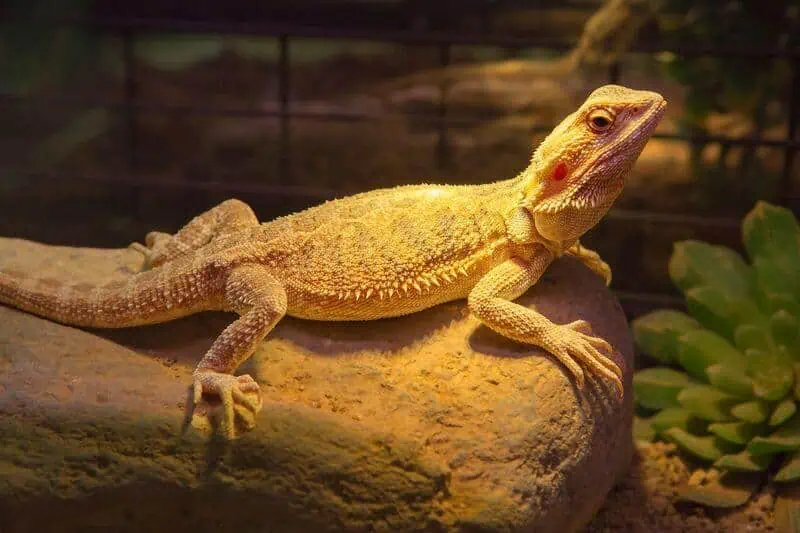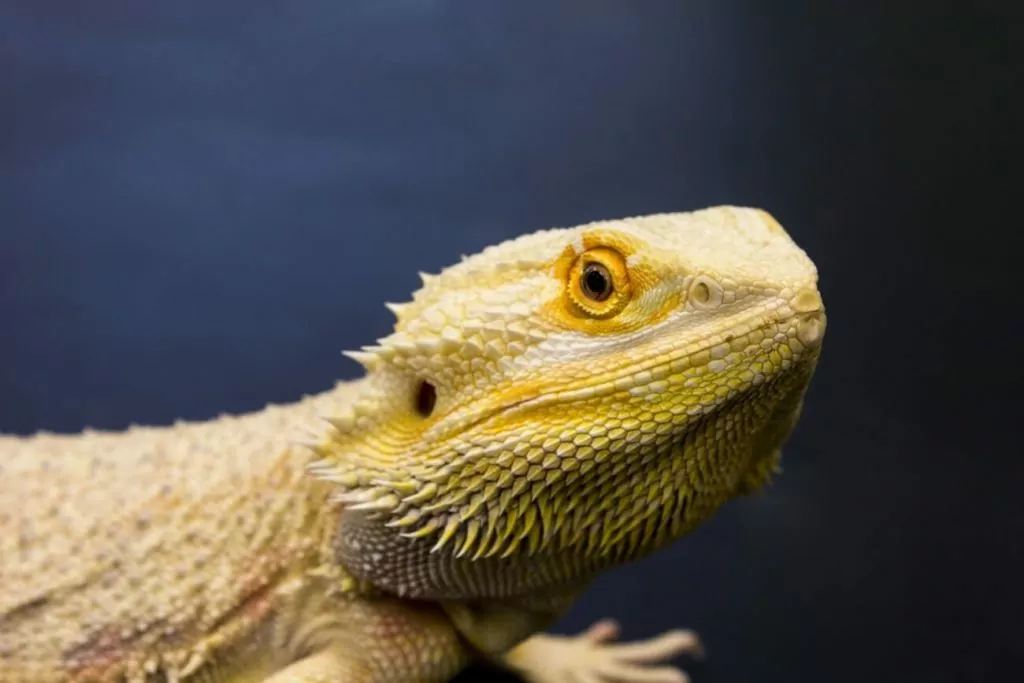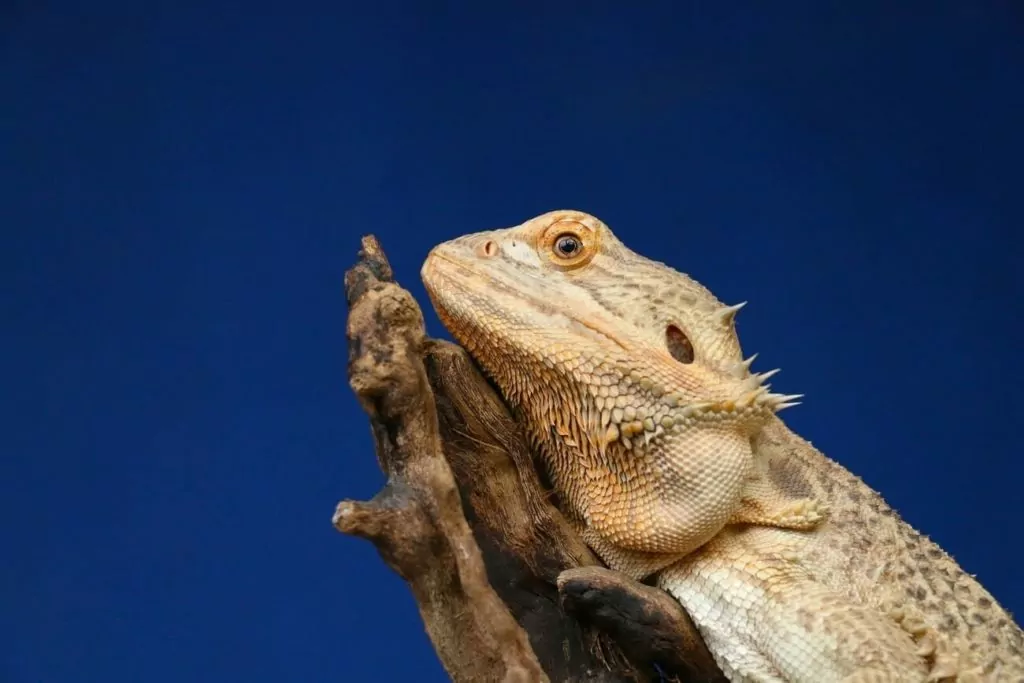Knowing how long a bearded dragon can go without heat is very important if you’re an owner. While this isn’t something you’ll have to deal with often, it’s important to be aware of in the event of an emergency.
This guide goes over how long bearded dragons can go without heat, so you can do whatever it takes to keep your pet safe.
Table of Contents
Why Is Heat Important For Bearded Dragons?
Warm temperatures are one of the most important environmental factors to maintain in a bearded dragon’s enclosure. These reptiles need heat to survive. Without it, bearded dragons can go into brumation or encounter severe health problems.
Bearded dragons are cold-blooded animals. They’re known as poikilotherms, hailing from arid regions in Australia. Beardies are used to having warm temperatures year-round. Because they’re cold-blooded, these reptiles must thermoregulate.
Unlike humans and mammals, bearded dragons cannot produce heat on their own. They lack the physiological functions to maintain body temperature. As a result, they have to reposition to stay warm.
Beardies move into basking lights to get more heat and into shadier areas to cool off. It’s why establishing a stable temperature gradient is paramount for bearded dragon enclosures.
Heat is also essential for many biological functions. It plays a part in calcium absorption and digestion. Without heat, your beardie can encounter many health problems. If they go too long without heat, it can even lead to death.
Generally, bearded dragon enclosures need an average temperature of around 90 degrees Fahrenheit. In the basking area, temperatures should be between 100 and 110 degrees. On the cooler side, temperatures can be as low as 70 degrees at night.
How Long Can A Bearded Dragon Go Without Heat?
If you’re worried about the consequences of no heat, here’s some information that can provide some peace of mind. Bearded dragons can usually go without heat for about 24 hours. That’s not enough for long-term survival, but it can buy you time to address the heating problems in the enclosure.
Now, there are some caveats. The 24-hour timeline is a guess at most. Realistically, your beardie should never get close to 24 hours without heat.
A full day of 24 hours without heat is pushing it, and there’s a good chance that lizards will experience complications far sooner. Digestion becomes a problem before the day is over.
Another thing to remember is that your 24-hour safety net only applies if the enclosure stays close to a safe temperature. These reptiles have their limits. They cannot survive in harsh winter conditions or remotely approaching freezing temperatures.
Expert Tip: If you live in a colder part of the world and ambient temperatures are low, your bearded dragon may not make it to 24 hours. This timeline only applies if the temperature is above 65 degrees Fahrenheit. That’s the threshold.
Anything less than that will cause health problems far sooner.
Fortunately, the residual heat from burnt-out lamps will take time to dissipate, even if you’re dealing with a power outage. That usually means you have enough time to address the issue without worrying about your lizard’s health.
However, you shouldn’t delay. When problems occur, you need to jump into action and minimize the time without heat as much as possible.
What To Do If Your Beardie Is Stuck Without Heat
If you’re like most owners, you’ve gone to great lengths to establish a healthy environment for your bearded dragon. You likely have a reliable lighting rig that hasn’t caused any problems.
But what happens when you suddenly can’t provide heat?
Things can happen. You may experience a power outage that lasts longer than expected. Or perhaps you have difficulty finding replacement bulbs for your lighting rig.
Whatever the case, you need to know what to do when your bearded dragon is stuck without heat.
The first thing you should do is check the temperature. It’s a good idea to have a couple of battery-powered digital thermometers on hand for situations like this. Don’t rely on built-in thermometers or heating systems alone to understand the conditions of the enclosure.
Check the temperature to know where you’re starting. We recommend checking it regularly every hour.
The temperature won’t fall dramatically the moment the lights go out. The decrease occurs slowly, so you need to monitor the temperature and ensure it’s at safe levels. Remember: 65 degrees is the safety threshold.
Once you understand the temperature, quickly cover the enclosure. Your goal is to minimize heat loss as much as possible. Avoiding it completely is impossible, but closing the tank will help slow things down. It’ll also help maintain humidity levels, which are equally important.
Your next move should be to increase the heat in the room. Ambient temperatures will affect the temperature in the enclosure. The colder it is, the quicker thermal loss will occur.
Raising the temperature in the room will keep things nice and toasty for your bearded dragon.
Our next tip is to consider using heat sources that aren’t tied to your lighting rig. This only works if you’re dealing with burnt-out lamps. If you have a power outage, you likely won’t be able to run any additional heater.
But if you can, consider turning them on to maintain stable temperatures. You can use ceramic heat emitters, under-tank heating pads, etc.
You may consider bringing your beardie outside if you know you can’t address the heat issue for a while. Only do this if it’s warmer than 65 degrees Fahrenheit and you have ample access to direct sunlight. A few hours outside is a great way to bridge the gap and give your lizard everything it needs to stay comfortable.
Of course, make sure your reptile is contained. Set up barriers to prevent their escape. It’s also a good idea to set up your outdoor pen in an area that offers direct sunshine and shade.
They’ll use the setup the same way they would the lamps in the enclosure, moving from the shade to full-sun basking spots as they see fit.
Emergency Options
So, what if you can’t keep the room warm or bring your bearded dragon outside?
We have a few emergency tips you can use to extend how long your bearded dragon can go without heat.
The first is to use a heat pack or a bottle filled with hot water. If you choose the former, make sure it doesn’t contain any toxic chemicals or has a design that’s easy to break. Place the pack into the enclosure; its heat will provide temporary warmth.
The same goes for the water bottle technique. Fill the bottle with hot water, place it in an area your bearded dragon can’t access, and it’ll give off warmth for a bit before the water cools.
Refill the bottle as many times as you need to keep temperatures up.
Our final tip is to wrap your lizard up in warm blankets. Never place your beardie above any direct heating sources that aren’t reptile-safe. Instead, warm the blanket and wrap them up to absorb the residual heat.
You can create a beardie burrito and hold it against your body. It’s a great way to bond while giving your lizard some of your body heat.
Safety Precautions To Make Sure Your Bearded Dragon Doesn’t Go Without Heat
Now that you know how long a bearded dragon can go without heat and things you can do during an emergency, let’s talk prevention.
There are a few safety precautions you can take to ensure that your beardie never goes without heat. These include putting your heating systems on a timer, investing in backup power, and gathering emergency supplies.
Use A Timer
If you don’t have your lighting system on a timer, now’s the time to upgrade. Timers ensure that your bearded dragon is getting heat and light at precisely the same time every day. Not only that, but it keeps your lizard safe against unplanned emergencies or whenever you forget to do things manually.
A timer can be a lifesaver. Say, for example, that an emergency prevents you from returning home and turning the lamps on in the morning. In that case, the timer would do everything for you.
Set your time to turn on the lights at the appropriate time. Bearded dragons should receive heat and light for about 12 hours a day. Darkness is also necessary for maintaining your lizard’s circadian rhythm, so make sure the timer turns everything off at night.
Expert Tip: If you live in a colder climate, you can also use heat emitters to provide warmth throughout the night. Your timer should be scheduled to turn those accessories on once the lights go out.
Have A Backup Power Source
A backup power generator is a great way to cover your bases during a power outage. In parts of the world that experience storms and blackouts pretty frequently, generators are common. They turn on automatically once power from the grid goes out, providing you with constant power until it is restored.
There are many types of generators available. Whole-home generators can provide you with several days of power. However, they’re a big investment and require permanent installation.
Consider a portable power generator or power station if you’re on a budget. These devices usually run on battery power. They don’t last as long and can’t provide your entire home with power.
However, they’re a great safety precaution you can use solely for your bearded dragon’s enclosure. Have one charged up and ready to go, and you can quickly plug in your heating and lighting systems whenever you experience an outage.
Be Prepared With Supplies
Our final tip is to have supplies ready. You’d be surprised by how much some extra preparation can be. Consider creating a backup kit for the worst-case scenario.
Gather supplies to overcome power outages. You can get a box of air-activated hand warmers to use in the enclosure, self-heating mats, battery-powered lights, etc. Having all of that on hand makes a difference.
Don’t stop there.
We also recommend having extra bulbs on hand at all times. Instead of buying new bulbs each time, have extras on backup whenever one goes out. This move alone can greatly minimize how long your bearded dragon has to go without heat.
Conclusion
Now that you know how long a bearded dragon can go without heat, it’s time for you to do some preparation. If you don’t think you have the necessary setup to keep them toasty during an emergency, change that!
Let us know if you have any questions about this. We’re always happy to help owners keep their beardies safe and warm.



